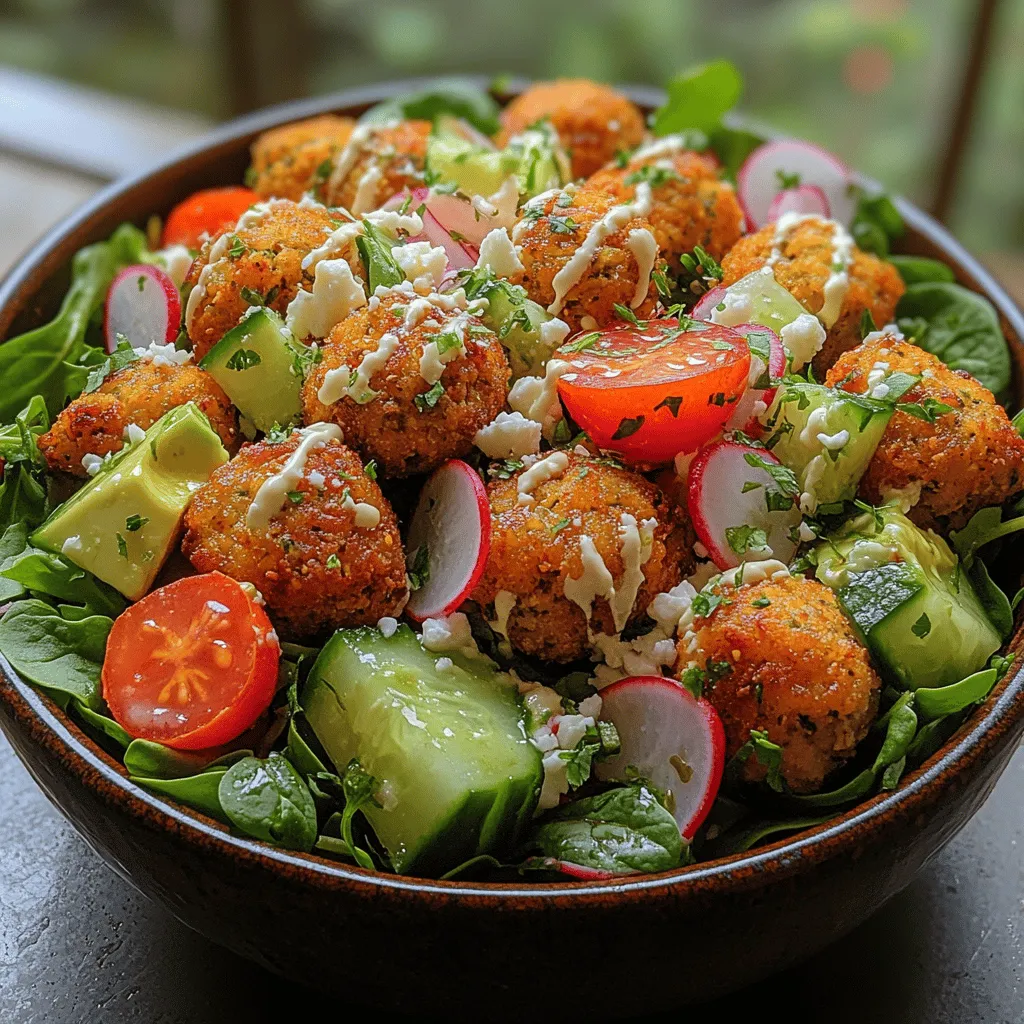Crispy Falafel Salad Bowl Recipe
Falafel is more than just a dish; it’s a cultural icon that has transcended borders to become a beloved staple in kitchens around the world, especially among vegetarian and vegan communities. Originating from the Middle East, this deep-fried ball or patty made from ground chickpeas (or fava beans) is celebrated for its versatility. Whether served in a pita, on a platter with hummus, or as a star ingredient in a vibrant salad bowl, falafel offers a satisfying crunch and a burst of flavor that appeals to a variety of palates. In this article, we will explore how to create a crispy falafel salad bowl that not only delights the taste buds but also aligns with a healthy lifestyle.
Incorporating a crispy falafel salad bowl into your diet brings numerous benefits. First and foremost, the freshness of ingredients used in this recipe is a game changer. Crisp mixed greens, juicy tomatoes, and refreshing cucumbers come together to form a colorful base that complements the warm, crunchy falafel perfectly. This dish not only provides a satisfying crunch but also nourishes your body with essential nutrients. The combination of plant-based proteins, healthy fats, and fiber makes it a wholesome meal option that can keep you feeling full and energized.
As we delve deeper into this recipe, you will discover how it harmonizes nutritious components with bold flavors, making it a delightful addition to your meal rotation.
Understanding Falafel
To fully appreciate the crispy falafel salad bowl, it’s important to understand the roots of falafel itself. Its origins are somewhat debated, with various theories suggesting that it may have originated in Egypt, where it was made with fava beans, before spreading throughout the Middle East. Over time, falafel has become a symbol of Middle Eastern cuisine, embraced by numerous cultures and modified to suit local tastes.
The traditional falafel recipe centers around chickpeas, which are not only the main ingredient but also the backbone of the dish. Chickpeas are packed with protein and fiber, making them an excellent choice for those seeking a nutritious alternative to meat. They are also rich in vitamins and minerals, such as iron, magnesium, and folate, contributing to a well-rounded diet.
Falafel is typically seasoned with a vibrant mix of herbs and spices. Fresh parsley and cilantro add a burst of color and freshness, while spices like cumin and coriander impart warmth and depth of flavor. This unique blend not only enhances the taste but also elevates the nutritional profile, ensuring that each bite is both delicious and beneficial for your health.
Ingredients Breakdown
Creating a crispy falafel salad bowl requires a careful selection of ingredients, each playing a vital role in the overall flavor and texture of the dish. Here’s a closer look at the key components:
– Chickpeas: As the foundation of falafel, chickpeas provide essential protein and fiber. When cooked and mashed, they form the basis of the mixture that is shaped into balls or patties before frying. For the best texture, it’s recommended to use dried chickpeas that have been soaked, as this helps them maintain their shape during cooking.
– Herbs and Spices: The flavor profile of falafel is largely defined by the herbs and spices used in its preparation. Fresh parsley and cilantro not only add vibrant color but also bring a fresh, earthy taste. Cumin and coriander are essential spices that add warmth and complexity, making each bite a flavorful experience.
– Vegetables in the Salad: The salad component of this bowl enhances its nutritional value and adds a delightful crunch. Mixed greens provide a variety of vitamins and minerals, while cucumbers offer hydration and a refreshing crunch. Tomatoes, rich in antioxidants, add juiciness and a hint of sweetness, creating a balanced flavor profile.
– Tahini Dressing: No falafel salad bowl is complete without a creamy dressing to tie everything together. A simple tahini dressing made from tahini, lemon juice, and olive oil not only adds a rich, nutty flavor but also boosts the overall nutritional content with healthy fats. This dressing enhances the dish’s texture, creating a luscious coating that complements the crispy falafel.
Preparation Steps
Now that we’ve covered the ingredients, let’s walk through the initial stages of preparing this delicious crispy falafel salad bowl. The first critical step involves soaking the chickpeas, which is essential for achieving the perfect falafel texture.
– Soaking Chickpeas: Start by placing dried chickpeas in a bowl and covering them with plenty of water. Allow them to soak overnight, or for at least 8 hours. This process rehydrates the chickpeas and softens them, making them easier to blend and shape into falafel. Avoid using canned chickpeas, as they contain added liquids that can alter the consistency of your falafel mixture.
In the next section of this article, we will continue with the preparation steps, including blending the chickpeas with herbs and spices, shaping the falafel, and cooking them to golden perfection. Stay tuned as we guide you through this delicious journey to create a crispy falafel salad bowl that’s sure to impress!

Making the Falafel Mixture
To create the perfect falafel mixture, begin by processing your key ingredients: soaked chickpeas, fresh herbs, garlic, onion, and spices. It’s essential to soak the dried chickpeas in water for at least 8 hours or overnight, as this will soften them and allow for better blending. Once soaked, drain the chickpeas and place them in a food processor along with a handful of fresh parsley and cilantro, one or two cloves of garlic, half an onion, and spices such as cumin, coriander, salt, and pepper.
Pulse the mixture until it reaches a coarse but uniform consistency. Avoid over-processing; you want the mixture to retain some texture, which will help the falafel hold its shape during frying. The ideal consistency is slightly sticky but not too wet. If the mixture feels too dry, you can add a splash of water or a tablespoon of tahini for moisture. Once blended, let the mixture sit for about 30 minutes. This resting period allows the flavors to meld and the mixture to firm up, making it easier to shape into balls or patties.
Forming and Frying Falafel
Once your falafel mixture is ready, it’s time to shape it. Use your hands to form small balls or patties, about the size of a golf ball. If the mixture is too sticky, lightly wet your hands to prevent sticking. For an even better texture, you can refrigerate the formed falafel for about 15-30 minutes to help them firm up more before frying.
Next, heat vegetable oil in a deep frying pan or pot over medium-high heat. You’ll want enough oil to submerge the falafel balls halfway, usually about 2-3 inches deep. To check if the oil is hot enough, drop a small piece of the falafel mixture into the oil; if it sizzles immediately, it’s ready.
Carefully place the falafel into the hot oil, a few at a time, to avoid overcrowding the pan. Fry them for about 4-5 minutes on each side or until they turn golden brown and crispy. Use a slotted spoon to remove the falafel and drain them on paper towels to absorb excess oil. This frying technique ensures a crunchy exterior while keeping the inside tender and flavorful.
Creating the Salad
With the falafel frying, you can now assemble your salad. Begin with a base of fresh greens—romaine lettuce, spinach, or mixed greens work wonderfully. Layer in vibrant vegetables such as diced cucumbers, cherry tomatoes, shredded carrots, and bell peppers for added color and crunch. For an extra layer of flavor, consider adding sliced radishes or pickled red onions.
To create a well-rounded salad bowl, don’t forget to include some healthy fats and proteins. Avocado slices are an excellent addition that complements the falafel, while chickpeas can add more texture and nutrition. You might also want to sprinkle some sunflower seeds or pumpkin seeds for an added crunch.
Crafting the Dressing
A tahini dressing is the perfect complement to your crispy falafel salad bowl. In a mixing bowl, combine tahini with fresh lemon juice, minced garlic, water, and a pinch of salt. Whisk until smooth, adding more water if necessary to achieve your desired dressing consistency. Aim for a creamy yet pourable texture. Adjust the flavor by adding more lemon juice for acidity or a touch of maple syrup for sweetness. This balanced dressing will enhance all the flavors in your salad without overpowering the dish.
Assembling the Crispy Falafel Salad Bowl
Now it’s time to bring everything together. In a large bowl, start by adding a generous portion of your greens as the foundation. Next, arrange the layered vegetables in a visually appealing manner—this not only enhances the presentation but also makes each bite a delightful mix of flavors.
Place the crispy falafel on top, allowing them to shine in the center of the bowl. Drizzle your tahini dressing generously over the top, ensuring that each component gets a taste of it. For an added touch of creaminess and flavor, consider crumbling some feta cheese over the salad, which provides a nice contrast to the crispy falafel. However, for a completely vegan dish, feel free to omit the cheese.
Serving Suggestions
The beauty of the crispy falafel salad bowl is its versatility. You can customize it to your liking by adding grains such as quinoa or couscous to make it heartier. These grains can serve as an additional base, offering a chewy texture that complements the crispy falafel beautifully.
Consider including toppings like olives or nuts for unique flavors and textures. Sliced black olives can bring a briny depth, while toasted almonds or walnuts can add a satisfying crunch.
For a complete meal, serve the salad alongside warm pita bread or pita chips. This not only enhances the dining experience but allows you to scoop up the salad with the bread, making each bite even more enjoyable. Pair your salad with a refreshing beverage, such as a homemade lemonade or a light herbal tea, to balance the flavors.
Nutritional Information
The crispy falafel salad bowl is not only delicious but also packed with nutritional benefits. A typical serving contains approximately 400-500 calories, depending on the amount of dressing and toppings used. The falafel itself is rich in plant-based protein, fiber, and essential vitamins, making it a great option for those following a vegetarian or vegan diet.
Rich in vitamins A and C from the fresh vegetables, this salad bowl also provides healthy fats from the tahini and avocado. It’s naturally gluten-free as long as you skip the pita or use gluten-free alternatives. This recipe is perfect for anyone looking to maintain a balanced diet while enjoying a flavorful meal.
Conclusion
The crispy falafel salad bowl is a delightful combination of textures and flavors that offers numerous health benefits. With its vibrant ingredients and the crunch of perfectly fried falafel, this dish is sure to satisfy your cravings for something fresh and filling.
Encourage yourself to experiment with the recipe, adapting it to your taste preferences and dietary needs. The joy of creating a wholesome meal from scratch is further enhanced when shared with family and friends. So gather your ingredients, roll up your sleeves, and enjoy the process of crafting a beautiful and nutritious crispy falafel salad bowl.

